 |
A great deal of information and encouragement has been provided by Sewell V. Sample. |
 |
|
|
|
|
 |
A great deal of information and encouragement has been provided by Sewell V. Sample. |
 |
|
|
|
|
Please visit the Sewell Genealogy Site Map for other pages in this series.
| Click for
PDF index |
The information presented here has
been taken from the following sources:
World Book Millenium 2000 Deluxe Edition,
© 1999 World Book Inc., © IBM Corp.
Microsoft Encarta Encyclopædia 99,
© 1993-1998 Microsoft Corporation
Norman F. Cantor (ed.): The Encyclopædia
of the Middle Ages, New York, 1999
Berhard Grun: The Timetables of History,
New York, 1991
George Andrews Moriarty: The
Plantagenet Ancestry of King Edward III and Queen Philippa,
The ancient Kings of Scotland claimed a legendary antiquity beginning with Gaythelos, son of a King of Greece who went to Egypt during the time of Moses where he married a daughter of the Pharaoh. Not to be outdone, the Kings of Wessex developed a legendary ancestry beginning with the Biblical Adam and Eve. This legendary genealogy is recorded in the Anglo-Saxon Chronicle, a collection of documents commissioned by Alfred the Great in the late 9th century.
The entry in the Anglo-Saxon Chronicle for the year A.D. 854 relates the descent of Æthelwulf, Alfred the Great's father:
"And Æthelwulf was the son of Egbert, Egbert of Ealhmund, Ealhmund of Eafa, Eafa of Eoppa, Eoppa of Ingild; Ingild was the brother of Ina, king of the West-Saxons, who held that kingdom thirty-seven winters, and afterwards went to St. Peter, where he died. And they were the sons of Cenred, Cenred of Ceolwald, Ceolwald of Cutha, Cutha of Cuthwin, Cuthwin of Ceawlin, Ceawlin of Cynric, Cynric of Creoda, Creoda of Cerdic, Cerdic of Elesa, Elesa of Esla, Esla of Gewis, Gewis of Wig, Wig of Freawine, Freawine of Frithugar, Frithugar of Brond, Brond of Balday, Balday of Woden, Woden of Frithuwald, Frithuwald of Freawine, Freawine of Frithuwualf, Frithuwulf of Finn, Finn of Godwulf, Godwulf of Great, Great of Taetwa, Taetwa of Beaw, Beaw of Sceldwa, Sceldwa of Heremod, Heremod of Itermon, Itermon of Hathra, Hathra of Hwala, Hwala of Bedwig, Bedwig of Sceaf; that is, the son of Noah, who was born in Noah's ark: Laznech, Methusalem, Enoh, Jared, Malalahel, Cainion, Enos, Seth, Adam the first man, and our Father, that is, Christ. Amen."
The pre-Christian Kings of Wessex
claimed a descent that originated with King Priam of Troy through the Viking
god Thór. This line, from Snorri Sturluson's Icelandic
Prose Edda, proceeds:
"Priam, High King of Troy; Tróán; Thór; Lóridi; Einridi, Vingethor, Vingerner, Móda; Magi; Seskef; Bedwig; . . . " This line then proceeds as for the Anglo-Saxon Chronicle from Bedwig, son of Sceaf who was born in Noah's ark. It is interesting to note that although the Anglo-Saxon Chronicle gave the kings a Christian origin, it includes the Norse god Woden or Odin who married the god Frigg or Frígídá.
However, as with the Scots, history knows nothing of this prior to about 500 AD, at which point the name of Cerdic emerges from the mists of legend as a Saxon invader who established himself as King of Wessex. Thus, it is with Cerdic that we will begin this genealogical record. This is not a list of kings. For the Kings of Wessex from Cerdic to Ælfred the Great, click on Kings of Wessex.
Generation One
Cerdic, King of Wessex
Died in 534
Cerdic and his son Cynric landed in
the area of Southhampton in 495 A.D., and then moved north into what is
now Hampshire and Wiltshire to found The Kingdom of the West Saxons or
Wessex. Cerdic met great resistance from the last of the Romano-Britons
under a shadowy leader who lays as good a claim as any to having been the
"real" King Arthur. Cerdic was crowned as the 1st King of West Saxons
at Winchester 532, although some say he reigned from 519 on. The times
were very chaotic, and although leaders such as Cerdic are historical figures,
much of the actual history is shrouded in legend.
Cerdic had the following sons:
Generation Two
Cynric, King of Wessex
Died in 560
Cynric reigned from 534 to 560.
He defeated the Romano-Britons at Salisbury in 552. Cynric faced
competition from Stuf and Wihtgar, who came to Wessex in 514 and were said
to be "nefa" of Cerdic and Cynric. The term "nefa" means both nephew
and grandson, and it has been suggested that Stuf and Wihtgar were father
and son; possibly a son and grandson of Cerdic's sister and a Jutish nobleman.
In 534, Cynric gave the Isle of Wight to Stuf and Wihtgar.
Cynric had the following sons:
Generation Three
Ceawlin, King of Wessex
Died in 593
Ceawlin reigned from 560 to
592 at which time he was deposed by his nephew Ceola. He captured
Gloucester and Bath from the Britons in 577. Although Ceawlin is
a historical figure, the facts are far from clear. His brothers,
Cutha and Cuthwulf appear to have led some or all the West Saxons between
568 and 584.
Ceawlin had the following sons:
| Generation Four
Cuthwine, an under ruler in Wessex, died in 584, who had the following sons:
|
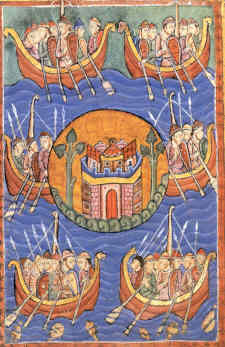
Angles, Saxons and Jutes invading Britain by sea |
Generation Seven
Cenred, an under ruler in
Sommerset who acceded in 694, and who had the following children:
| Generation Eight
Ingild (died in 718) who had a son:
|

Stockaded homestead of a Saxon chieftain |
Generation Eleven
Ealhmund, Under-King of Kent from
784 to his death in 786.
Died in 786
Ealhmund married a daughter of Æthelbert
II who was King of Kent from 725 to 762; and who ruled Kent jointly with
first with his brother Eadberht (725 - 748), and later with his half brother
Alric and nephew Eardwulf.
Ealhmund and his wife (the daughter of Æthelbert II, King of Kent) had the following children:
Generation Twelve
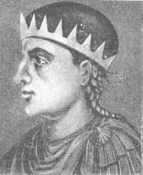 Ecgbert
III, King of Wessex & England from 802 to
839
Ecgbert
III, King of Wessex & England from 802 to
839
Born about 775
Died on February 4, 839 and interred at Winchester Cathedral,
England
Ecgbert reigned from 802 to 839. In 800
at the decline of the power of King Brithric (786 - 802), Egbert was called
by the voice of his countrymen to assume the Government of Wessex, and
he subsequently succeeded in reducing all the Kingdoms
of the Heptarchy under his sway. His reign, a long and glorious
one, is memorable for the great victories he achieved over the Danes.
Ecgbert married to Redburga (also Rædburh)
about whom little is known.
Redburga is referred to as a "sister of the Frankish King" (George
Andrews Moriarty: The Plantagenet Ancestry of King Edward III and
Queen Philippa, Salt Lake City, 1985, page 16) However, this
is unlikely because at the time of their marriage, Ecgbert was an Under-King
of a small part of what is now England. There would have been a huge
gap in status between Ecgbert's family and that of the rulers of Western
Europe. Perhaps she was an illegitimate relative of Charlemagne.
Ecgbert and Redburga had the following children:
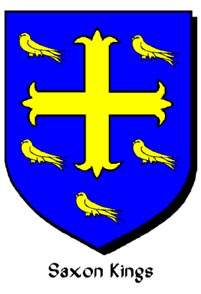 Generation
Thirteen
Generation
Thirteen
Æthelwulf, King of England
from 839 to 856
Born about 800
Died on January 13, 858 and interred at Winchester Cathedral,
England
Æthelwulf reigned from
839 to 856 at which point he abdicated in favour of his son Æthelbald
after returning from a lengthy pilgrimmage. He was Under-king of
Kent 825 - 839 and 856 - 858. Renown for his military prowess, he
reputedly defeated 350 viking ships. He reduced taxation, endowed
the Church, made lay lands inheritable, and provided systems of poor relief.
Æthelwulf married first circa 830 to Osburga, daughter of Oslac, Thane of Isle of Wight and "Pincerna Regis" or Grand Butler of England; called a descendant of Wihtgar, a nephew of Cerdic who ruled the Isle of Wight in the 6th century. Æthelwulf and Osburga had the following children:
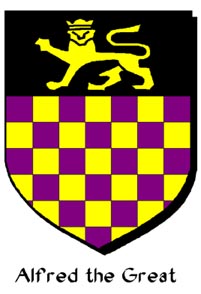
Generation Fourteen
Alfred the Great, King of England
from 871 to his death in 899
Born in 849 at Wantage, Berkshire
Died on October 28, 899 and interred at Hyde Abbey,
Winchester
Alfred prevented the Danish
conquest of England, defeating them at Edington in 878 after a campaign
of guerrila warfare. After his victory he allowed the Danes to keep their
conquests in Mercia and East Anglia provided that Guthrum, their king,
was converted to Christianity. Alfred built a navy of Warships to defend
the south coast against further Danish invasions (885 - 886; 892 - 896)
and protected Wessex with a chain of fortifications. He took London in
886, thereby gaining control of all England except the Danish areas.
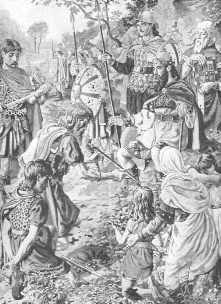 |
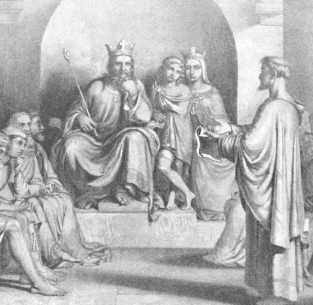 |
|
surrendering to Alfred the Great |
at the Witan, or Assembly of the Wise. |
Alfred married in 868 to Ealhswith, a Mercian noblewoman,
daughter of Æthelred Mucil "the Great", Ealdorman of the Gainas and
his wife Eadburgh of the Royal House of Mercia. This marriage revived the
ties between Sessex and Mercia; and provided Alfred with a powerful ally
north of the Thames.
Alfred and Ealhswith had the following children:
Generation Fifteen
Edward the Elder, King of England
from 899 to his death in 924
Born in 869
Died on July 17, 924 at Farndon-on-Dee and interred at
Winchester Cathedral, England
Edward built upon the successes
of his father Alfred and set about creating a new Kingdom of England.
He defeated the Danes in 918, taking East Anglia, and also conquered Mercia
in 918 and Northumbria in 920.
Edward married first to Ecgwyn (died circa 901) and they had the following children:
Generation Sixteen
Edmund I the Elder, King of England from
939 to his death in 946
Born in 921
Died on May 26, 946 at Pucklechurch, Dorset and
interred at Glastonbury Abbey, Somerset
Edmund defeated two Norse kings
in Northumbria and also defeated the Britons in Strathclyde who had been
supporting the Norsemen. He then gave Strathclyde to King Malcolm
I of Scotland in return for a treaty of alliance. This ensured a half century
of peace between Scotland and Saxon England.
Edmund was murdered by an outlaw named
Leolf who stabbed him to death at a banquet to St.Augustine on May 26,
946 at Pucklechurch, Dorset.
Edmund married first to St. Ælfgifu (died in 944) and they had the following children:
Generation Seventeen
Edgar the Peaceful, King of England
from 959 to his death in 975
Born in 944
Died on July 8, 975 at Winchester, England
and interred at Glastonbury Abbey, Somerset
Edgar was the first King of
a united England. He allowed his Danish subjects to retain Danish laws,
he promoted a monastic revival and he encouraged trade by reforming the
currency. Edgar improved defence by organising coastal naval patrols and
a system for manning warships.
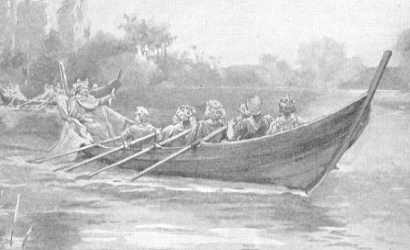 |
being rowed down the Dee. Following his coronation, Edgar
|
Generation Eighteen
Æthelred II the Unrede, King of England
from 978 to 1016
Born about 968
Died on April 23, 1016 at London, and interred at St.Paul's
Cathedral; but his tomb was lost when the old St Paul's was destroyed in
the great fire of London.
The name Æthelred means “noble
council”, but a cynical 13th century pun suggested his name should have
been “evil council” or “unrede” because he said to have participated in
a plot to murder his half brother St. Edward the Martyr. However, he was
only about 10 years old at the time, and it is diffiuclt to imagine how
a child could have been a participant in such a heinous crime. Regardless,
Æthelred’s name "the Unrede" stuck. The name "the Unready" was coined
centuries later and is mistaken.
Æthelred reigned from
979 to 1013, at which time he was temporarily deposed by King Sweyn Forkbeard
of Denmark, who was never actually crowned King of England. When
Sweyn died on February 3, 1014, the Witan recalled Æthelred who then
reigned until his death on April 23, 1016.
Æthelred married first about 985 to Elfreda (Ælfgifu), a daughter of either Æthelbert, an Ealdorman; or Thored, Ealdorman of York. Æthelred and Elfreda (Ælfgifu) had the following children:
Æthelred may have married to Ælthelgife,
a daughter of Egbert who is not shown in all genealogies.
Æthelred married on April 5, 1002 to Emma of Normandy Please click on Emma of Normandy for her descent and second marriage to King Canute. Æthelred and Emma had the following children:
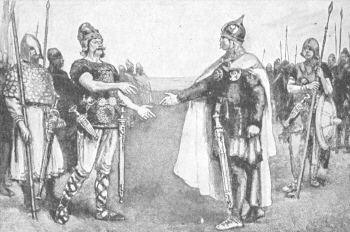 |
Edmund Ironside and Canute were engaged in a bitter struggle for possession of English territory, and they agreed to partition the country between them in 1016. After Edmund's death on November 30, 1016, Canute was proclaimed king of all England, which became a leading province a Scandinavian empire. Canute proved a good king whose fairness and honesty exceeded that of any previous king. |
Edmund married in 1015 to Ealdgyth, widow of Sigeferth,
a Danish Thane who was killed in 1015. Ealdgyth may have been a daughter
of Morcar, Earl of Northumbria, and is also said to be "of Welsh royal
blood". Ealdgyth's parentage is uncertain.
Edmund Ironside and Ealdgyth had the following
sons:
Edward married in Hungary to Agatha, who is said to have been a daughter of either:
Generation Twenty-one
St. Margaret the Exile
Born in 1045 in Hungary
Died on November 16, 1093 at Edinburgh Castle.
She was interred at Dunfermline Abbey, Fife, Scotland; but her remains
were later removed to Escorial, Spain and her head Douai, France.
St. Margaret arrived at the English court of Edward the Confessor in 1057. Ten years later she was in exile after William the Conqueror defeated Harold Godwineson at the Battle of Hastings. She fled to Scotland where she was married against her wishes to King Malcolm to whom she bore six sons and two daughters. St. Margaret was canonised 1250 and her feast day is November 16th.
St. Margaret married in 1068 to Malcolm III Cænnmor of Scotland, King of Scotland.
For the continuation of this line, click on St. Margaret the Exile.
Click to return to the top of this page.
Please visit the Sewell Genealogy Site Map for other pages.
 |